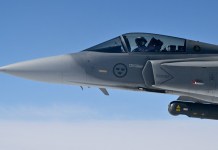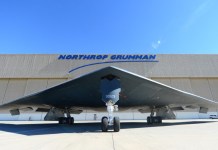Pakistan has announced the production of the Block III variant of the JF-17 Thunder. The Pakistani/ Chinese JF-17 Thunder Block-3 is considered the most advanced version and experts claim it to be as capable as the Rafale jets.
US To Sell 6 AH-64E Apache ‘Guardian’ Gunships To Kuwait; Bombs & Gadgets To Saudi Arabia & Egypt
The JF-17 is a lightweight, single-engine, multi-role fighter that was designed in the wake of the PAF seeking a replacement for their aging combat aircraft such as the A-5C, F-7P/PG, Mirage III, and Mirage V.
A product of the collaboration between the Pakistan Aeronautical Complex (PAC) and the Chengdu Aircraft Corporation (CAC) of China, the JF-17 can fulfill multiple roles including interception, ground attack, anti-ship, and aerial reconnaissance.
With a current fleet of more than 100 JF-17 fighters, the Pakistan Air Force believes it has the necessary air power to confront its eastern rival, the Indian Air Force (IAF).

On Wednesday, the PAF welcomed the double-seater JF-17B aircraft into its fleet during an event at the Kamra Airbase in the Attock district of the country. PAF spokesman, Air Commodore Ahmer Raza, said the new model would mostly be used for training purposes.
“The missiles and radar in the new planes are the same as the old planes, just one seat has been added in the new model so that the other pilot can sit and we can use these planes in training,” said Raza.
According to the PAF, while the aircraft will meet the training needs, it is fully capable of being deployed in combat operations, thereby, enhancing the Air Force’s operational capability.
The PAF also launched the production of the Block III variants of the JF-17 Thunder on the same day. It claims the Block III will be the most advanced variant of the fighter and aid Pakistan in maintaining a balance of resistance in the changing situation in the region.
According to the PAF, new radars will be installed on Block III aside from modern weapons and missiles. Moreover, the focus has been on enhancing the Electronic Warfare (EW) capabilities.
“(The Block III aircraft) will be ready in about one and a half years,” said Raza.
According to retired Pakistani Air Marshal Maqsood Akhtar, the Block III JF-17 will be a fourth-generation aircraft possessing an active electronically secondary radar and better missiles.
Block 3’s JF-17 aircraft will be equipped with air-to-ground and air-to-air weapons, he said.
On the other hand, India’s ‘4+ generation’ Rafale is a twin-engine, canard-delta wing, multirole fighter aircraft equipped with a wide range of weapons.
Received earlier this year by the Indian Air Force, the fighter can perform air supremacy, interdiction, aerial reconnaissance, ground support, in-depth strike, anti-ship strike, and nuclear deterrence missions.
PAF Spokesman Raza claimed the JF-17 Block III would be even better than India’s Rafale fighters.
“Block III will be better than Rafale in many respects. It will be an aircraft that can compete with the Rafales,” said Raza.
However, Dr. Adil Sultan, acting dean and Head of Department, Faculty of Aerospace Sciences and Strategic Studies, has a different take.
“We compare everything in the context of Pakistan and India. Each aircraft has its own role. We can say in this context that this plane can be a little better than the Rafale, but there are many more things to look at when comparing planes,” he said.
So, how different are the two fighters?
Multi-Role Vs Omni-Role Aircraft
The JF-17s are multi-role combat fighter aircraft (MRCA) that are intended to perform various day/night roles during combat.
The fighters can carry out different tasks including air-to-air attack, air-to-surface attack, aerial reconnaissance, interception, suppression of enemy air defense, anti-ship strikes, and nuclear deterrence.
On the other hand, the Rafales are “omni-role” fighters, with the tag indicating that their abilities “go beyond the needs of each type of mission’.
According to their French manufacturer, Dassault, “When the Rafale program was launched, the French Air Force and French Navy published a joint requirement for an omni-role aircraft that would have to replace the seven types of combat aircraft then in operation.”
Other Specifications – JF-17 vs Rafale Jets
While the empty weight of the French Rafales ranges from 9900 kg to 10600 kg depending on its variant and maximum take-off weight of 24, 500 kg, the JF-17s are much lighter, weighing around 6,411kg with a maximum take-off weight of 12,474 kg.
The end result is that Rafales are much more capable of carrying more fuel and weapons per flight as compared to the Pakistani JF-17s.
Rafales are incredibly speedy and possess the ability to attain speeds up to Mach 1.8/750 kt (2,222.6 km per hour). On the other hand, the JF-17s can only muster top speeds of 1.6 Mach or 1975.68 km/ hour.
The aircraft’s operational range refers to the maximum distance it can travel from its base, and it seems the Rafale is way ahead in this aspect.
The Rafales are much superior to the JF-17s and can fly up to a range of 3,700 km, which could be further increased if the fighter is refueled mid-air. The JF-17 is reported to have a maximum ferry range of 2,037 km and therefore falls behind Rafales in this segment.
Follow EurAsian Times on Google News




